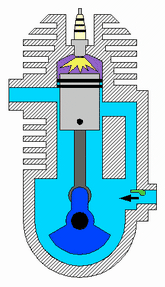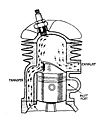Two-stroke engine facts for kids
A two-stroke engine is a type of engine that creates power in just two main movements. These movements are called "strokes." This is different from a four-stroke engine, which needs four movements. Two-stroke engines are often used in smaller machines. You might find them in things like chainsaws, leaf blowers, or some dirt bikes. They are known for being simple and powerful for their size.
Contents
How a Two-Stroke Engine Works
A two-stroke engine gets its name because it completes a full power cycle in only two movements of its piston. Let's look at these two important steps.
Stroke 1: Compression and Power
- Piston moves up: The piston moves upwards inside the engine. As it goes up, it squeezes the mixture of fuel and air. This makes the mixture very compact and ready to burn.
- Spark and Power: At the top, a spark plug creates a spark. This spark ignites the squeezed fuel-air mixture. The burning gas expands quickly, pushing the piston down with a lot of force. This is the "power stroke" that makes the engine work.
Stroke 2: Exhaust and Intake
- Piston moves down: As the piston continues to move downwards after the power stroke, it uncovers special openings called "ports."
- Old gas out, new gas in: One port lets the burnt exhaust gases escape. At the same time, a fresh mixture of fuel and air is pushed into the engine through another port. This new mixture helps push out the old exhaust gas.
- Ready for next cycle: Once the piston reaches the bottom, it's ready to start moving up again for the next cycle.
Key Differences from Other Engines
Unlike a four-stroke engine, a two-stroke engine does not have separate movements just for bringing in new fuel or pushing out old exhaust. It does both of these jobs during the piston's downward movement. When the piston is at the very bottom, new fuel and air are blown in. This incoming mixture helps to push out the old exhaust gases at the same time. Some engines use a special fan called a rotary blower to help push in the fuel-air mixture.
Images for kids
-
Lateral view of a two-stroke Forty series British Seagull outboard engine from 1954/1955
-
Deflector piston with cross-flow scavenging
-
Brons two-stroke V8 diesel engine driving an N.V. Heemaf generator
See also
 In Spanish: Motor de dos tiempos para niños
In Spanish: Motor de dos tiempos para niños






